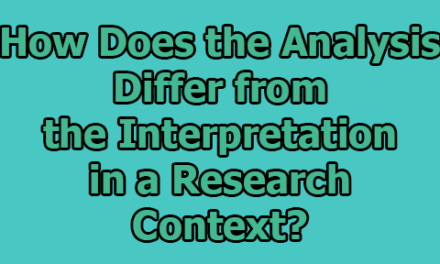How to Write Significance of the Study in Research:
The Significance of the Study is an important component of any research project. It is a section that explains the importance or relevance of the study in terms of its potential contributions to the field of study. The significance of the study can help to clarify the purpose of the research, identify the potential benefits of the research, and provide a context for the research. In this article, we will provide a detailed guide on how to write the significance of the study in research.
i. Introduction: In the introduction section of the significance of the study, it is important to provide a brief overview of the research project. This section should include a clear statement of the research question, research objectives, and the scope of the study. The introduction should also provide a brief overview of the research design and methodology to give readers a general idea of how the study will be conducted.
For example; this research project aims to investigate the effectiveness of online learning in higher education. The research will focus on a specific online learning platform and will examine the impact of this platform on student engagement, motivation, and academic performance.
ii. Background: The background section of the significance of the study provides a context for the research. It should explain why the research is important and provide a brief overview of the current state of knowledge in the field. This section should include a review of relevant literature, including key studies and theories that have influenced the development of the research question. The background should be written in a way that is accessible to readers who may not be familiar with the specific field of study.
For example; online learning has become increasingly popular in higher education in recent years. However, there is limited research on the effectiveness of specific online learning platforms and their impact on student outcomes. Existing research has focused primarily on comparing online and face-to-face instruction, rather than examining the unique features of specific online learning platforms.
iii. Research Gap: The research gap section of the significance of the study identifies the gap or problem in the current state of knowledge that the research aims to address. This section should explain why the gap exists and why it is important to address it. The research gap section should also provide a clear explanation of how the research aims to address the gap. This section is critical because it helps readers understand the need for the research and the potential impact it could have.
For example; despite the growing popularity of online learning, there is a lack of research on the effectiveness of specific online learning platforms. This research aims to address this gap by examining the impact of a specific online learning platform on student outcomes.
iv. Research Objectives: The research objectives section of the significance of the study provides a clear and concise explanation of the research objectives. This section should explain what the research aims to achieve and how it will do so. It should also provide a rationale for why these objectives are important and how they relate to the research gap. The research objectives should be specific, measurable, achievable, relevant, and time-bound (SMART).
For example; the research objectives of this study are to:
- Examine the impact of the online learning platform on student engagement.
- Assess the impact of the online learning platform on student motivation.
- Evaluate the impact of the online learning platform on student academic performance.
v. Research Questions and Hypotheses: The research questions and hypotheses section of the significance of the study provides a clear and concise explanation of the research questions and hypotheses. This section should explain how the research questions and hypotheses relate to the research objectives and the research gap. It should also provide a rationale for why these research questions and hypotheses are important. Research questions should be open-ended, while hypotheses should be testable and falsifiable.
For example; the research questions and hypotheses of this study are as follows:
The research questions:
- How does the online learning platform impact student engagement?
- Does the online learning platform have an effect on student motivation?
- What is the relationship between the online learning platform and student academic performance?
Hypotheses:
- Students who use the online learning platform will report higher levels of engagement than those who do not use the platform.
- Students who use the online learning platform will report higher levels of motivation than those who do not use the platform.
- Students who use the online learning platform will perform better academically than those who do not use the platform.
vi. Contribution to the Field: The contribution to the field section of the significance of the study explains the potential contributions of the research to the field of study. This section should provide a clear and concise explanation of how the research will advance knowledge in the field, and it should explain the potential implications of the research for theory, practice, and policy. This section helps readers understand why the research is important and how it could make a meaningful contribution to the field.
For example; this research will contribute to the field of online learning by providing insights into the effectiveness of a specific online learning platform. The findings of this study will inform the development of future online learning platforms and may help educators to make informed decisions about the use of online learning in higher education.
vii. Practical Implications: The practical implications section of the significance of the study explains the potential practical applications of the research. This section should explain how the research findings could be applied in practice, and it should identify the potential benefits of these applications. This section helps readers understand how the research could have a real-world impact and why it is relevant beyond the academic community.
For example; the findings of this study may have practical implications for educators and students. The results could be used to inform the development of online learning platforms that better support student engagement, motivation, and academic performance. Additionally, the findings may be used to inform decisions about the use of online learning in higher education.
viii. Conclusion: The conclusion section of the significance of the study provides a summary of the key points made in the previous sections. It should restate the research objectives, research questions, and hypotheses, and it should summarize the potential contributions of the research to the field of study and its practical implications. This section helps to tie everything together and leaves readers with a clear understanding of the research project’s significance.
For example; in conclusion, this research project aims to examine the effectiveness of a specific online learning platform in higher education. The research objectives, research questions, and hypotheses have been clearly defined. The research aims to contribute to the field of online learning by providing insights into the effectiveness of specific online learning platforms, and the findings may have practical implications for educators and students.
ix. Limitations: The limitations section of the significance of the study identifies any potential limitations of the research project. This section should explain the potential challenges or barriers that the research might face, and it should provide a plan for how to mitigate these limitations. This section helps readers understand the potential weaknesses of the research project and how they may impact the validity and generalizability of the study’s findings.
For example; one potential limitation of this study is that it focuses on a single online learning platform. Therefore, the findings may not be generalizable to other online learning platforms. Additionally, the study relies on self-reported data, which may be subject to bias.
x. Future Research: The future research section of the significance of the study suggests potential areas for future research. This section should provide recommendations for how the research could be extended or improved in the future. It should also highlight any unanswered questions or areas of ambiguity that may require further research. This section helps readers understand the potential for future research in the field and the ways in which the current research could serve as a foundation for future studies.
For example; future research could explore the effectiveness of other online learning platforms or compare the effectiveness of multiple platforms. Additionally, future research could examine the impact of online learning on specific student populations, such as non-traditional students or students with disabilities.
xi. Significance Statement: Finally, the significance statement is a concise summary of the research project’s main contributions, practical implications, and potential impact on the field. This section should be written in a way that is accessible to a wide range of audiences, including non-specialists. It is often used in grant applications and other contexts where a brief and compelling summary of the research project is required.
For example; this research project will provide valuable insights into the effectiveness of a specific online learning platform and has the potential to inform the development of future online learning platforms. The findings of this study may have practical implications for educators and students, helping to improve the quality of online learning in higher education. This study will contribute to the growing body of research on online learning and will help to fill a gap in the literature on the effectiveness of specific online learning platforms.
From the above discussion, we can say that the significance of the study is an essential component of any research project. It provides readers with a clear understanding of the research’s purpose, objectives, and potential impact. By following the guidelines outlined above, researchers can write a clear and compelling significance of the study that helps readers understand the importance of their research and its potential implications.
References:
- Baumgartner, S. E., & Chung, H. (2014). Confidence limits for intraclass reliability coefficients. Measurement in Physical Education and Exercise Science, 18(3), 181-196.
- Campbell, J. (2013). What is the difference between a research question and a hypothesis? Journal of Epidemiology and Community Health, 67(4), 318.
- Creswell, J. W. (2014). Research design: qualitative, quantitative, and mixed methods approaches. Sage publications.
- Fischer, C. T. (2004). Bracketing in qualitative research: Conceptual and practical matters. Psychotherapy Research, 14(2), 141-151.
- Polit, D. F., & Beck, C. T. (2017). Nursing research: generating and assessing evidence for nursing practice. Wolters Kluwer Health/Lippincott Williams & Wilkins.
- Rudestam, K. E., & Newton, R. R. (2015). Surviving your dissertation: A comprehensive guide to content and process. Sage publications.
- Trochim, W. M. K. (2006). Research methods knowledge base.
- The University of Southern California. (n.d.). Writing a Dissertation: The Importance of Alignment. Retrieved from https://rossier.usc.edu/writing-a-dissertation-the-importance-of-alignment/
- Walden University. (n.d.). Writing a Dissertation: Significance/Contributions. Retrieved from https://academicguides.waldenu.edu/writingcenter/scholarlyvoice/dissertation/significance
- World Health Organization. (n.d.). Research Proposal Outline. Retrieved from https://www.who.int/rpc/research_ethics/research_proposal_outline_en.pdf

Former Student at Rajshahi University










